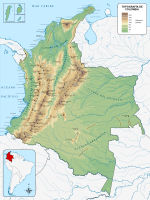Cordillera Oriental montane forests
The extensive region of submontane and montane forests includes distinctive flora and fauna in the north, center and southern sections.
Despite extensive changes due to logging, farming and ranching, large areas of the original habitat remain intact, and the ecoregion has rich biodiversity.
The southeastern slope extends southward from the west of the Tamá Massif past (and including) the Serranía de la Macarena.
In the wider, northern section of this slope there are high, flat plains and páramos, and permanently snow covered peaks such as the 5,493 metres (18,022 ft) Sierra Nevada del Cocuy.
The 1,800 metres (5,900 ft) Serranía de la Macarena runs in a southeast direction from the southern part of the slope into lowland moist forest.
[3] Other endangered mammals include Geoffroy's spider monkey (Ateles geoffroyi), red-crested tree-rat (Santamartamys rufodorsalis), mountain tapir (Tapirus pinchaque) and woodland Oldfield mouse (Thomasomys hylophilus).
[6] Endangered reptiles include Anolis ruizii and Colombian lightbulb lizard (Riama columbiana).
[3] Other endangered birds include chestnut-bellied hummingbird (Amazilia castaneiventris), Táchira antpitta (Grallaria chthonia), Cundinamarca antpitta (Grallaria kaestneri), Colombian mountain grackle (Macroagelaius subalaris), Perijá metaltail (Metallura iracunda), gorgeted wood quail (Odontophorus strophium), yellow-eared parrot (Ognorhynchus icterotis), helmeted curassow (Pauxi pauxi), Antioquia bristle tyrant (Phylloscartes lanyoni), Bogotá rail (Rallus semiplumbeus), Perijá thistletail (Asthenes perijana), black-and-chestnut eagle (Spizaetus isidori) and Niceforo's wren (Thryophilus nicefori).
[3] Endangered amphibians include Atelopus minutulus, Atelopus petriruizi, Centrolene petrophilum, Cryptobatrachus nicefori, Gastrotheca espeletia, Gastrotheca orophylax, Gastrotheca ruizi, Charta tree frog (Hyloscirtus denticulentus), Rio Chingual Valley tree frog (Hyloscirtus pantostictus), Papallacta tree frog (Hyloscirtus psarolaimus), Hypodactylus elassodiscus and Pristimantis merostictus.
[6] Of the Ithomiini and Heliconiinae butterfly subfamilies in the Serranía del Perijá, 80% are found in the Sierra Nevada but only 40% in the eastern cordillera slopes.
[3] The World Wildlife Fund (WWF) gives the Cordillera Oriental montane forests ecoregion a status of "Vulnerable".
Colonization in the foothills in the Amazon region and the Serranía de la Macarena is introducing subsistence agriculture and widespread grazing.
[3] The 3,000 square kilometres (1,200 sq mi) Sierra de Perijá National Park in Venezuela has been proposed as a biosphere reserve.




